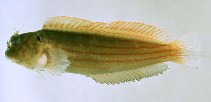| Family: |
Blenniidae (Combtooth blennies), subfamily: Salariinae |
| Max. size: |
5.59 cm SL (male/unsexed) |
| Environment: |
demersal; marine; depth range 0 - 5 m |
| Distribution: |
Northwest Pacific: Shirahama, Wakayama Prefecture, Japan. |
| Diagnosis: |
Dorsal spines (total): 12-12; Dorsal soft rays (total): 16-16; Anal spines: 2-2; Anal soft rays: 17-17; Vertebrae: 32-32. Diagnosis: Dorsal fin XII, 16, membrane attached to caudal fin, with deep notch above last spine, first spine almost same or slightly higher than second; anal fin II, 17; pectoral rays 15; pelvic fin I, 4; caudal fin rays 13, procurrent rays 10, branched 9. Vertebrae 10 + 22. LL, without scales and scalelike flaps; LL tubes 2-11 (usually 5-9), canal ends below posterior to 7th dorsal ray. Upper lip crenulae 41. Gill rakers 23. Cephalic sensory pore complex. Cirri, nuchal 30, supraorbital 13, nasal 10; ventralmost nuchal cirri borne on greatly enlarged nuchal flap; cirri above flaps have no membranous ridge connection at their bases. Overall brown, head with scarlet reticulations, body with 5 scarlet stripes; dorsal fin with red spots and distal margin (Ref. 529, 635). |
| Biology: |
Found in a moderately exposed rocky reef about 3 m deep (Ref. 635). Oviparous. Eggs are demersal and adhesive (Ref. 205), and are attached to the substrate via a filamentous, adhesive pad or pedestal (Ref. 94114). Larvae are planktonic, often found in shallow, coastal waters (Ref. 94114). |
| IUCN Red List Status: |
Least Concern (LC); Date assessed: 24 March 2009 Ref. (130435)
|
| Threat to humans: |
harmless |
| Country info: |
|
Source and more info: www.fishbase.org. For personal, classroom, and other internal use only. Not for publication.

